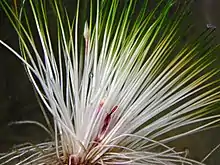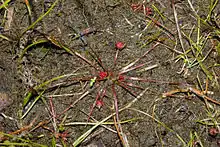Hydatellaceae
Hydatellaceae are a family of small, aquatic flowering plants. The family consists of tiny, relatively simple plants occurring in Australasia and India. It was formerly considered to be related to the grasses and sedges (order Poales), but has been reassigned to the order Nymphaeales as a result of DNA and morphological analyses showing that it represents one of the earliest groups to split off in flowering-plant phylogeny, rather than having a close relationship to monocots, which it bears a superficial resemblance to due to convergent evolution.[4] The family includes only the genus Trithuria, which has at least 13 species, although species diversity in the family has probably been substantially underestimated.[5]
| Hydatellaceae | |
|---|---|
_(20402793025).jpg.webp) | |
| Botanical illustration of Trithuria australis from 1904 | |
| Scientific classification | |
| Kingdom: | Plantae |
| Clade: | Tracheophytes |
| Clade: | Angiosperms |
| Order: | Nymphaeales |
| Family: | Hydatellaceae U.Hamann[1][2] |
| Genera[3] | |
|
Trithuria Hook.f. | |
Description


Plants are submerged and emergent aquatic plants, rooted in the substrate below the water. They are tiny plants, just a few cm tall. Most species are ephemeral aquatics that flower in vernal pools when the water draws down, but several species are submerged perennials found in shallow lakes. The simple leaves are concentrated basally around a short stem. Individual species are cosexual (with several types of hermaphroditic conditions) or dioecious, and are either wind-pollinated (anemophilous) or self-pollinating (autogamous). Two predominantly apomictic species are also known.[6] Flower-like reproductive units are composed of small collections of minute stamen- and/or pistil-like structures that may each represent very reduced individual flower, so that the reproductive units may be pseudanthia. The non-fleshy fruits are follicles or achenes.[2]
Taxonomy

The family was for many years assumed to be a close relative of the grasses and sedges and was even sometimes lumped under the poalean family Centrolepidaceae. Even as recently as 2003, the APG II system assigned Hydatellaceae to the grass order Poales in the commelinid monocots. However, research based on DNA sequences and morphology by Saarela et al. indicates that Hydatellaceae is the living sister group of the water lilies (Nymphaeaceae and Cabombaceae) and thus represents one of the most ancient lineages of flowering plants.[7] Developers of earlier classifications were misled by the apparently reduced vegetative and reproductive morphology of these plants. As aquatic herbs, Hydatellaceae have environmental adaptations leading to derived characteristics that create a morphological similarity to the more distant taxon. Careful reanalysis of their morphological traits and comparisons with other so-called 'basal' angiosperms have supported this "dramatic taxonomic adjustment".[8][9] This realignment is now recognized in the APG III and APG IV systems of classification.[1][10]
The family now includes only the genus Trithuria Hook.f., which in 2008 was re-defined to include the genus Hydatella Diels. The type species is Trithuria submersa Hook.f.[11]
References
- Angiosperm Phylogeny Group (2009). "An update of the Angiosperm Phylogeny Group classification for the orders and families of flowering plants: APG III". Botanical Journal of the Linnean Society. 161 (2): 105–121. doi:10.1111/j.1095-8339.2009.00996.x.
- Macfarlane, T.D.; Watson, L. & Marchant, N.G., eds. (2000). "Hydatellaceae U Hamann". FloraBase: Flora of Western Australian. Archived from the original on 14 July 2007. Retrieved 15 November 2013.
- "Hydatellaceae U.Hamann". Plants of the World Online. Royal Botanic Gardens, Kew. Retrieved 26 July 2023.
- Givnish, Thomas J.; Zuluaga, Alejandro; Spalink, Daniel; Soto Gomez, Marybel; Lam, Vivienne K. Y.; Saarela, Jeffrey M.; Sass, Chodon; Iles, William J. D.; de Sousa, Danilo José Lima; Leebens-Mack, James; Chris Pires, J.; Zomlefer, Wendy B.; Gandolfo, Maria A.; Davis, Jerrold I.; Stevenson, Dennis W.; dePamphilis, Claude; Specht, Chelsea D.; Graham, Sean W.; Barrett, Craig F.; Ané, Cécile (24 October 2018). "Monocot plastid phylogenomics, timeline, net rates of species diversification, the power of multi-gene analyses, and a functional model for the origin of monocots". American Journal of Botany. Wiley. 105 (11): 1888–1910. doi:10.1002/ajb2.1178. ISSN 0002-9122. PMID 30368769.
- Sokoloff, Dmitry D.; Marques, Isabel; Macfarlane, Terry D.; Remizowa, Margarita V.; Lam, Vivienne K.Y.; Pellicer, Jaume; Hidalgo, Oriane; Rudall, Paula J.; Graham, Sean W. (14 April 2019). "Cryptic species in an ancient flowering‐plant lineage (Hydatellaceae, Nymphaeales) revealed by molecular and micromorphological data". Taxon. Wiley. 68: 1–19. doi:10.1002/tax.12026. ISSN 0040-0262.
- Smissen, Rob D.; Ford, Kerry A.; Champion, Paul D.; Heenan, Peter B. (2019). "Genetic variation in Trithuria inconspicua and T. filamentosa (Hydatellaceae): a new subspecies and a hypothesis of apomixis arising within a predominantly selfing lineage". Australian Systematic Botany. CSIRO Publishing. doi:10.1071/sb18013. ISSN 1030-1887. S2CID 91261563.
- Saarela, Jeffery M.; Rai, Hardeep S.; Doyle, James A.; Endress, Peter K.; Mathews, Sarah; Marchant, Adam D.; Briggs, Barbara G. & Graham, Sean W. (2007). "Hydatellaceae identified as a new branch near the base of the angiosperm phylogenetic tree". Nature. 446 (7133): 312–315. Bibcode:2007Natur.446..312S. doi:10.1038/nature05612. PMID 17361182. S2CID 4415881.
- Rudall, Paula J.; Sokoloff, Dmitry D.; Remizowa, Margarita V.; Conran, John G.; Davis, Jerrold I.; Macfarlane, Terry D. & Stevenson, Dennis W. (2007). "Morphology of Hydatellaceae, an anomalous aquatic family recently recognized as an early-divergent angiosperm lineage". American Journal of Botany. 94 (7): 1073–1092. doi:10.3732/ajb.94.7.1073. hdl:2440/44423. PMID 21636477. S2CID 10405562.
- Friis, Else Marie; Crane, Peter R. & Pederses, Kaj Raunsgaard (2011). Early Flowers and Angiosperm Evolution. Cambridge University Press. ISBN 978-1-139-12392-1.
- Angiosperm Phylogeny Group (2016). "An update of the Angiosperm Phylogeny Group classification for the orders and families of flowering plants: APG IV". Botanical Journal of the Linnean Society. 181 (1): 1–20. doi:10.1111/boj.12385. ISSN 0024-4074.
- Sokoloff, Dmitry D.; Remizowa, Terry D. Macfarlane, Paula J. Rudall, Margarita V.; Macfarlane, Terry D. & Rudall, Paula J. (2008). "Classification of the early-divergent angiosperm family Hydatellaceae: one genus instead of two, four new species and sexual dimorphism in dioecious taxa" (PDF). Taxon. 57: 179–200.
{{cite journal}}: CS1 maint: multiple names: authors list (link)
External links
- Hydatellaceae in L. Watson and M.J. Dallwitz (1992 onwards).,The families of flowering plants: descriptions, illustrations, identification, information retrieval. Version: 27 April 2006. https://web.archive.org/web/20060424062016/http://delta-intkey.com/
- Hydatellaceae photographs
- NCBI Taxonomy Browser
 Data related to Hydatellaceae at Wikispecies
Data related to Hydatellaceae at Wikispecies